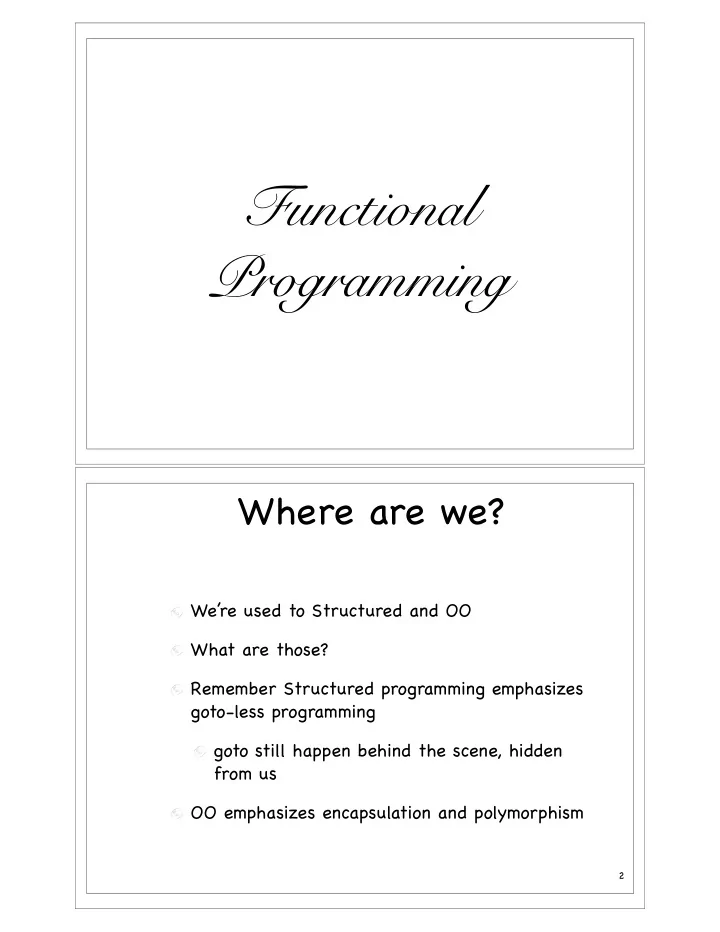

Functional Programming Where are we? We’re used to Structured and OO What are those? Remember Structured programming emphasizes goto-less programming goto still happen behind the scene, hidden from us OO emphasizes encapsulation and polymorphism 2
What’ s Functional Programming? It’ s a different way of programming It is Assignment-less Higher level of abstraction Expressions with no side effects Enables massive parallelism due to execution order independence 3 But, Why FP? We’re being dragged into it Dual core processors Multi-core processors High performance demand Intel Announced Qurd-core (By popular Demand!) We need software to function correctly Take performance advantage of hardware capabilities Need higher level of abstraction 4
What about familiar languages? What about languages like Ruby, Groovy,...? These are OO languages (we will look at these, but keep in mind, these are not functional langs) They have some features that have been borrowed from functional programming (like closures) So, you’re already using it to some extent These certainly bring the power, but we need more to tackle the evolving complexities 5 But, What’ s really FP? At the core of Functional Programming is higher order functions Works with Functional Abstraction and Mathematical Logic 6
What’ s a Function? Input Output f Function maps input to output But, what about algorithm, performance,... OK, function is what it does and how it does it A pure function does not perform any assignment operations—implicitly or explicitly 7 Independent evaluation order of subexpressions allow us to exploit multiprocessors Referential Transparency—allows elimination of common subexpressions Equations Imperative programs define variables explicitly— set values to variables —easier to program Functional programming languages do so implicitly—easier for formal specification a � 3 Explicitly defines a to be 3 a can now be substituted by 3 x = 2x - 3 Implicitly defines x to be 3 y = 2a + 5 => 2 * 3 + 5 => 11 x = 2a - 7 and a = x - 7; x and a implicitly defined using each other—x is 21 and a is 14. 8
Functions Functional programming languages try to express functions as recursions LISP showed how significant programs can be expressed as pure functions on list structures Promotes passing functions as arguments to functions-Higher Order Functions Functions operate on other functions without assignments or side effects 9 Higher Order Functions in Erlang 10
Similar Concept in Groovy 11 Similar Concept in Scala 12
Expressing Functions As Recursion 13 Expressing Functions As Recursion: Scala 14
Expressing Functions As Recursion 15 Expressing Functions As Recursion: Scala 16
What’ s Going on Here? Pattern Matching is at work When you call fib(3), it calls fib(N) When fib(N) calls fib(1), it ends up in fib(1) method instead of fib(N) 17 Let’ s Explore Pattern Matching Further 18
Pattern Matching and Recursion at Play 19 Pattern Matching and Recursion at Play: Scala 20
Another Solution: Scala 21 Curried Function Transforming a function that takes multiple arguments into a function that takes a single argument f(X, Y) � Z is transformed into curry(f): X � (Y � Z) Makes it easier to express Some languages have these built in Named after Haskell B. Curry Actual work by Moses Schönfinkel and Friedrich Ludwig Gottlob Frege 22
Curried Closure in Groovy 23 � -Calculus Formal system, introduced by Alonzo Church and Stephen Kleene, for function definition, function application, and recursion < � -term> ::= <variable> | ( � <variable>< � -term>) function definition | (< � -term>< � -term>) function application <variable> ::= x | y | z ... For example ( � x( � y((+x)y))) for f(x, y) = x + y Formalization for computability using transformations and substitutions Lead to Church-Turing theorem that it is impossible to decide algorithmically if general statements in arithmetic are true or false (Entscheidungsproblem or decision problem) “A little bit of syntax sugar helps you to swallow the � -calculus”—Peter J. Landin 24
Types Atoms are numbers, booleans, strings, non- composites, indivisible Sequences are composites and dividable if {x1, x2, ..., xn} � T, [x1, x2, ..., xn] � [T] An abstract types is specified in terms of abstract values without regard to any specific concrete implementation 25 Operations on Sequences first: [x1, x2, ..., xn] � x1 rest: [x1, x2, ..., xn] � [x2, ..., xn] prefix: x, [y1, y2, ..., yn] � [x, y1, y2, ..., yn] ... 26
Operations on Sequences 27 Operations on Sequences: Scala 28
Assignments in FPLs X = 3 Appears like assignment, but it’ s not X is first unbound. When you set it first time, it is bound What is Z = X + 1? If Z is not bound, Z is given value of 4. If Z is bound, checks if Z is equal to 4. {W, vapor} = {water, vapor}. W (variable) is bound to water (atom) in this case 29 List Comprehension Pattern matching helps make code concise List comprehension takes that one step further Here is an example to double elements in an array [X * 2 || X <- L] Says double element X where X is a member of sequence L Has generators and filters Generator helps generate sequence, filter helps limit or select elements 30
Count Even Using List Comprehension 31 Pick Even-Odd Using List Comprehension 32
Sort Using List Comprehension 33 Count Primes Using List Comprehension 34
Recommend
More recommend